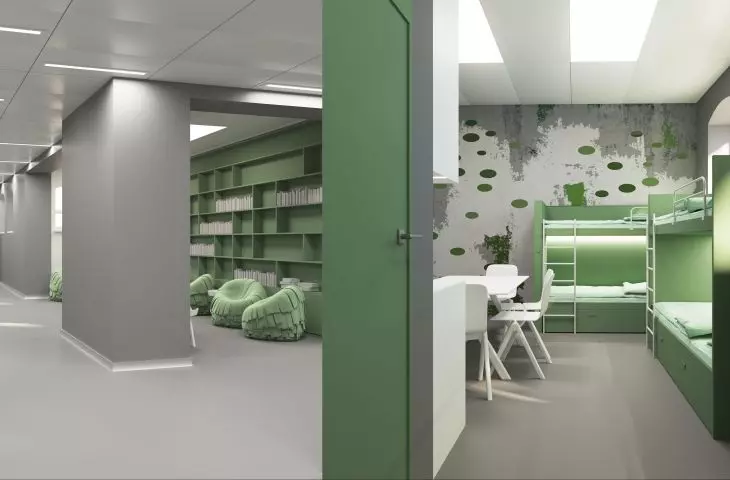Work submitted for the competition
"Best Interior Diploma 2020/2022".
The subject of the project is the regeneration of the female wards of the Opole Detention Center at 4 Sądowa Street to improve the welfare of inmates and contribute to better results of rehabilitation. The main design idea was to create a new concept for penitentiary facilities. The building regeneration project assumes preservation of the existing architectural structure while attempting to modernize it with available means that do not interfere with the historic building.
part of the corridor and the servants' hall
© Paulina Rybczynska
I decided to design the female part of the Detention Center in Opole. Based on the results of the WHOQOL-100 survey conducted among inmates, it can be concluded that the hygienic and equipment conditions did not meet the requirements of the inmates. Since the cells become a temporary place of residence, it is important to provide decent conditions that give a sense of normalcy. Changing the color scheme, furniture and ensuring the cleanliness of the relocation area is crucial. Transforming the space in this way can ensure positive results in the rehabilitation process in the future.
The designed space includes part of the first floor (female closed ward) and part of the second floor (female semi-open ward)
© Paulina Rybczynska
The designed space includes part of the first floor (female closed ward) and part of the second floor (female semi-open ward). The cells located on these floors can accommodate fifty-eight people and are divided into fourteen two-bed cells and seven six-bed cells. The first change visible at the entrance are the gray corridors, which, thanks to the use of epoxy flooring and wall paint of the same color, have balanced and muted the space. This treatment makes the whole space cohesive and harmonious. Shades of green, providing a natural color scheme, appear in the rooms and furnishings.
interior of a double cell
© Paulina Rybczynska
In the corridors of both wards, in addition to the introduction of a new color, the door woodwork and the bars separating the wards have been replaced. A semi-transparent plexiglass window has appeared between the bars of the bars, allowing some intimacy and freedom of movement in the wards. The first-floor corridor was opened up to accommodate the space of the dayroom, which in turn was swapped places with the educators' room. This change has made the corridor visually larger, and the social room has become a place where inmates can feel a distinct change of environment.
interior of a six-bed cell
© Paulina Rybczynska
New furniture made of laminated furniture board in RAL 000 90 00 color was placed in the cells, beds made of laminated furniture board in RAL 130 40 30 color, and due to the total enclosure they create small enclaves. At the base of the bed there are pull-out drawers, where residents can store their private belongings, this will further allow to take care of tidiness. The living areas also included large built-in cabinets, their absence often caused clutter. The single sink in the room was replaced by a small kitchenette with a sink and cabinets in which to store dishes or other utensils.
The interior of the chapel and children's meeting room
© Paulina Rybczynska
In each large cell, there is a graphic painted by the inmates on one of the walls. Initially, this painting was on the bedside tables, but in order to give the interior a more personal and homely feel, it was reproduced on the walls. The bathrooms in the six-bed cells featured showers and sinks.
Intimate visitation room, educators' room
© Paulina Rybczynska
Common rooms, such as the educators' room, the servants' room and the common room, are a color continuation of the corridors. They again feature shades of green, and the functional layout has been adjusted to meet the needs of the users.
Paulina Rybczynska
Illustrations: © Author



































































